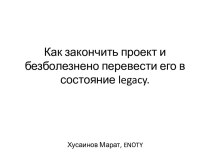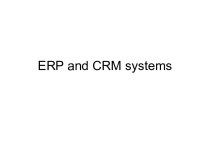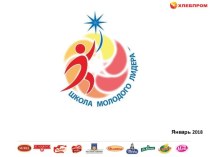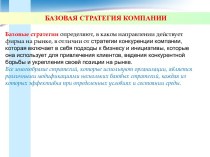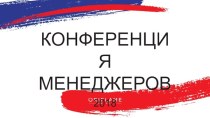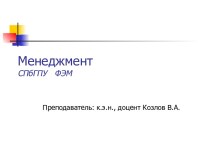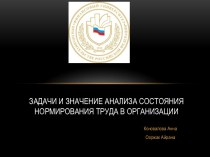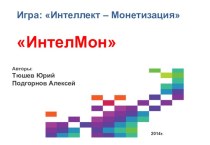- Главная
- Разное
- Бизнес и предпринимательство
- Образование
- Развлечения
- Государство
- Спорт
- Графика
- Культурология
- Еда и кулинария
- Лингвистика
- Религиоведение
- Черчение
- Физкультура
- ИЗО
- Психология
- Социология
- Английский язык
- Астрономия
- Алгебра
- Биология
- География
- Геометрия
- Детские презентации
- Информатика
- История
- Литература
- Маркетинг
- Математика
- Медицина
- Менеджмент
- Музыка
- МХК
- Немецкий язык
- ОБЖ
- Обществознание
- Окружающий мир
- Педагогика
- Русский язык
- Технология
- Физика
- Философия
- Химия
- Шаблоны, картинки для презентаций
- Экология
- Экономика
- Юриспруденция
Что такое findslide.org?
FindSlide.org - это сайт презентаций, докладов, шаблонов в формате PowerPoint.
Обратная связь
Email: Нажмите что бы посмотреть
Презентация на тему Knowledge management in smes. Dr. Susanne Durst
Содержание
- 2. AGENDABackgroundWhy knowledge management in SMEs?Challenges and areas of activity Knowledge management in SMEsCase studies
- 3. BACKGROUND Internal considerations (pull)The exploitation of knowledge
- 4. Aging workforce and shortage of skilled workersTo
- 5. WHY KM IN SMES?Exploitation of knowledge can
- 6. Most SMEs have no KM strategy and
- 7. KM IN SMES: OPPORTUNITIES AND CHALLENGES IOpportunitiesSmaller
- 8. ChallengesLimited personnel capacity and financial resources Lack
- 9. Conflicts as knowledge barriersEmployee acceptanceLack of exchange
- 10. ? Human, technical and organizational factors should
- 11. Organizational factorsAdvantages of SMEsFlatter structures and wide
- 12. Technical factorsDisadvantages of SMEsLimited financial resources Software
- 13. CASE STUDIES (BASED ON CEN, 2004) IField:
- 14. Field: IT integration / software developmentThe company
- 15. The installation of a central server as
- 16. Field: Software developmentThe software firm had two
- 17. Lessons learnedThe conversion of implicit knowledge to
- 18. The company develops, manufactures and sells light-sensitive
- 19. Скачать презентацию
- 20. Похожие презентации
AGENDABackgroundWhy knowledge management in SMEs?Challenges and areas of activity Knowledge management in SMEsCase studies
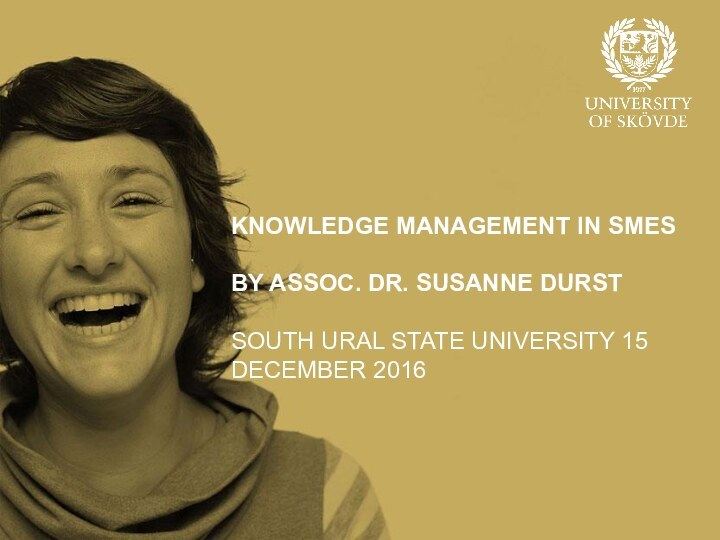
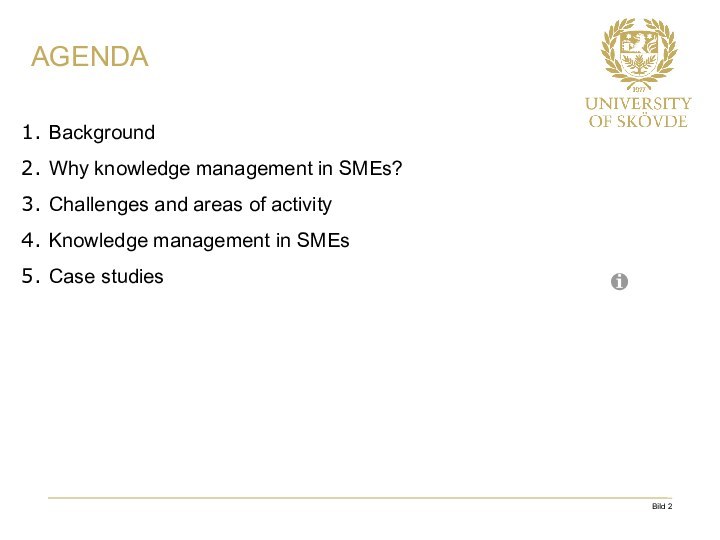
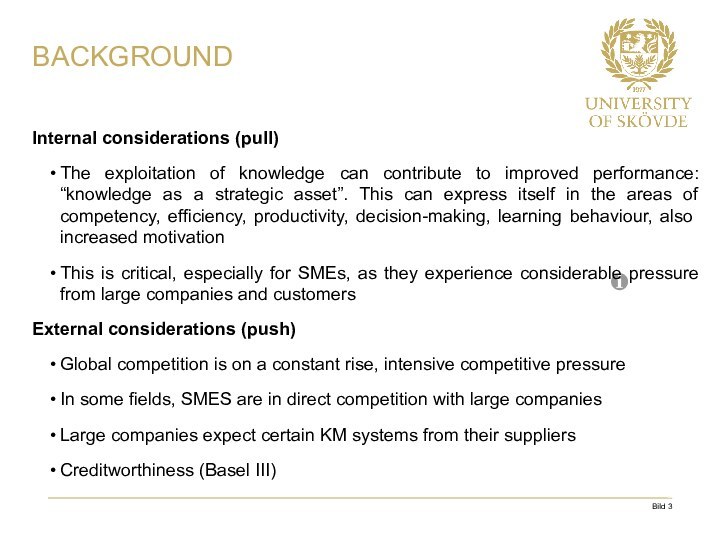
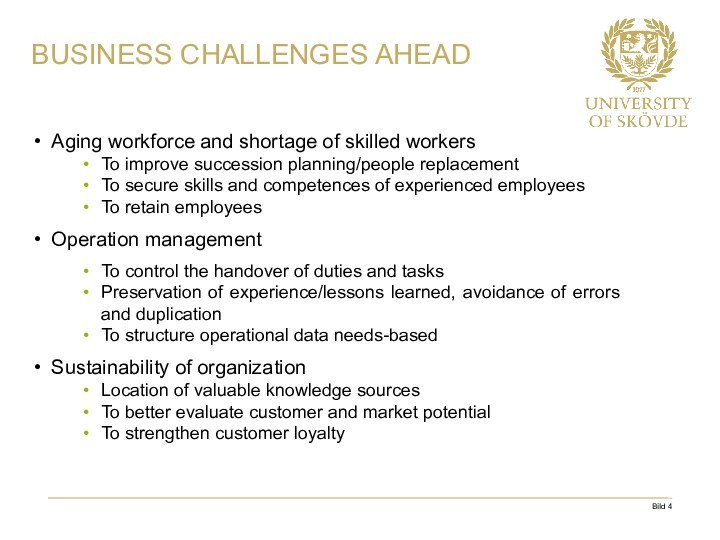
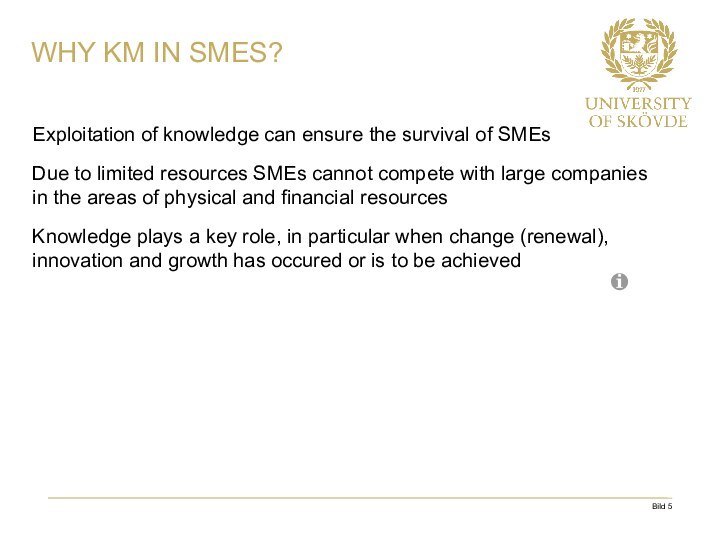
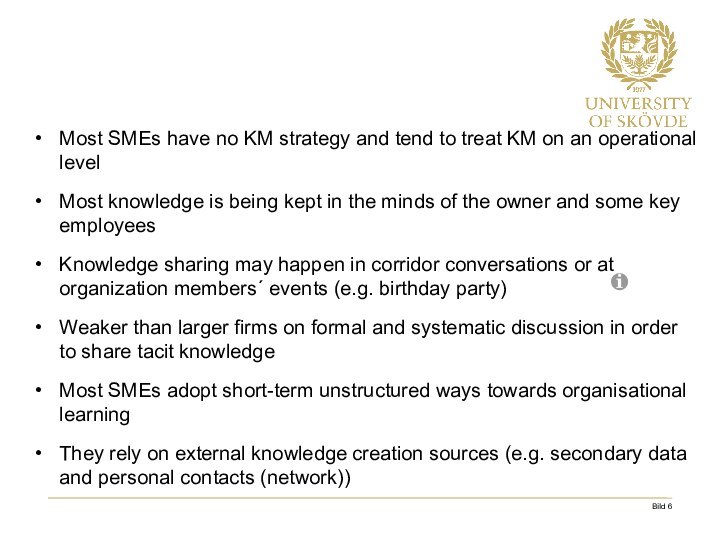
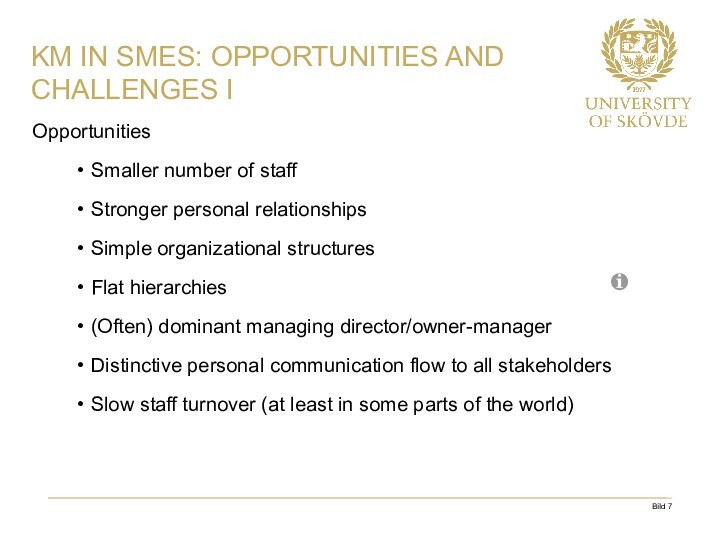
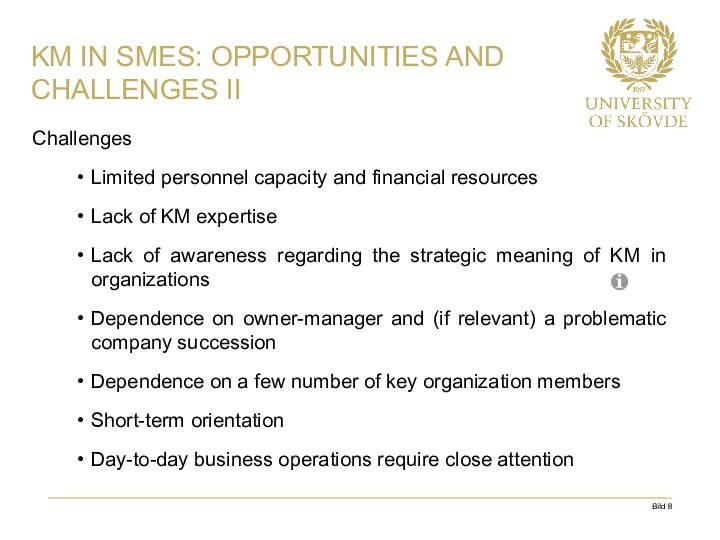

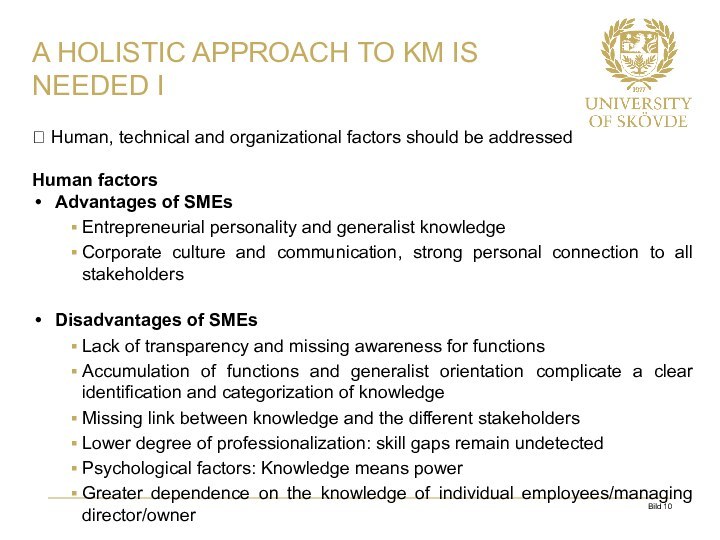
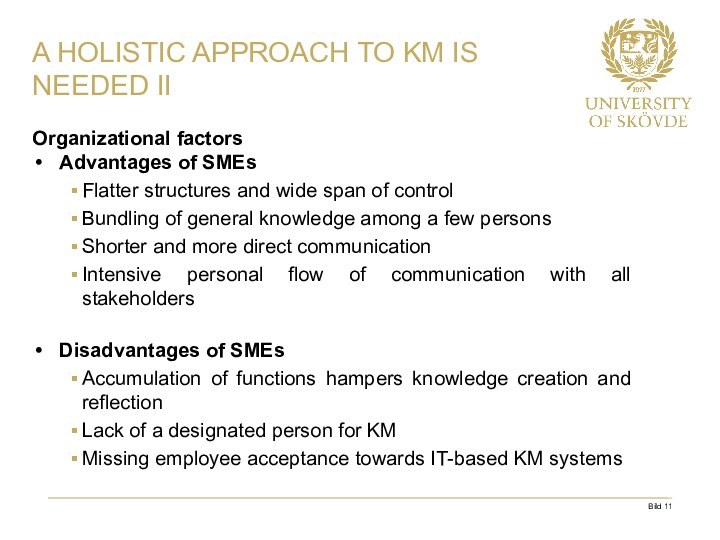
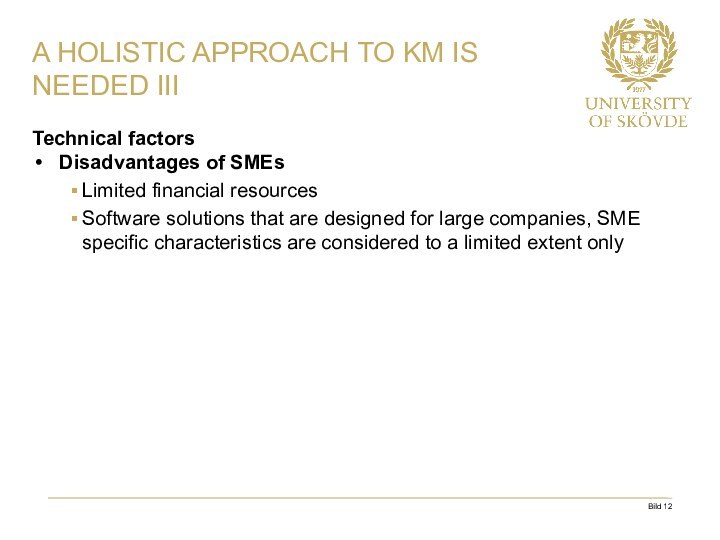

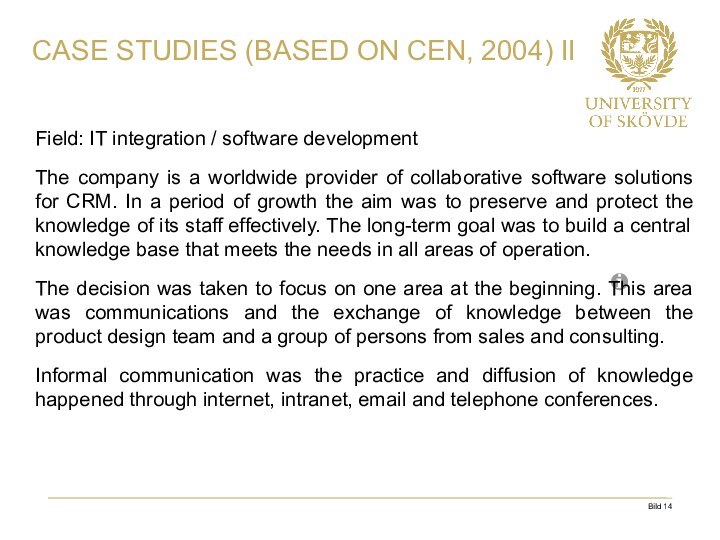

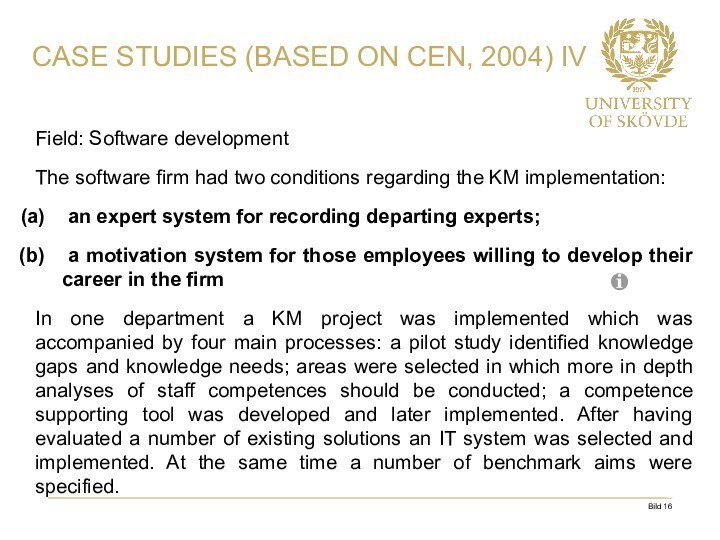

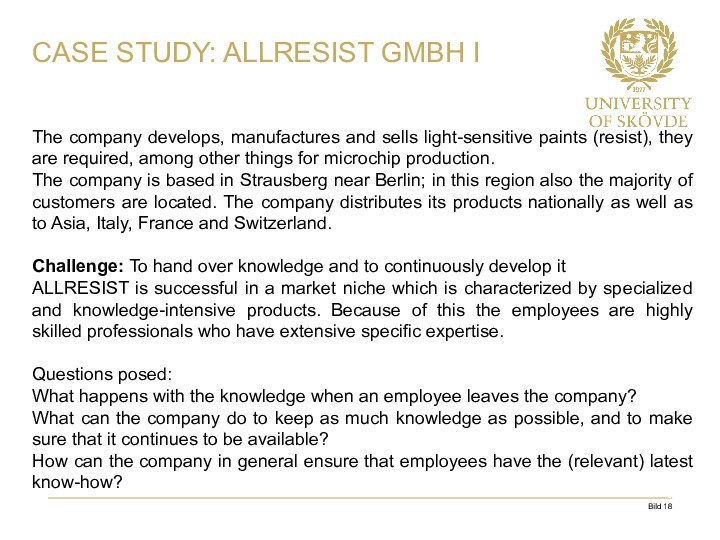
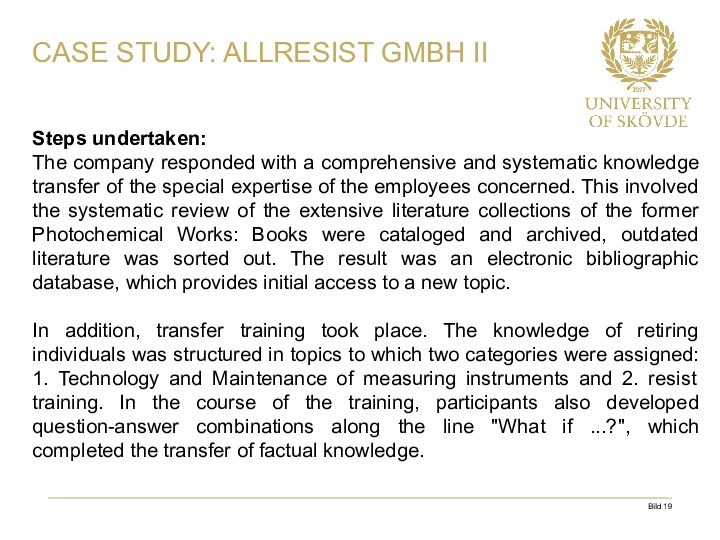
Слайд 3
BACKGROUND
Internal considerations (pull)
The exploitation of knowledge can
contribute to improved performance: “knowledge as a strategic asset”.
This can express itself in the areas of competency, efficiency, productivity, decision-making, learning behaviour, also increased motivationThis is critical, especially for SMEs, as they experience considerable pressure from large companies and customers
External considerations (push)
Global competition is on a constant rise, intensive competitive pressure
In some fields, SMES are in direct competition with large companies
Large companies expect certain KM systems from their suppliers
Creditworthiness (Basel III)
Слайд 4
Aging workforce and shortage of skilled workers
To improve
succession planning/people replacement
To secure skills and competences of experienced
employeesTo retain employees
Operation management
To control the handover of duties and tasks
Preservation of experience/lessons learned, avoidance of errors and duplication
To structure operational data needs-based
Sustainability of organization
Location of valuable knowledge sources
To better evaluate customer and market potential
To strengthen customer loyalty
BUSINESS CHALLENGES AHEAD
Слайд 5
WHY KM IN SMES?
Exploitation of knowledge can ensure
the survival of SMEs
Due to limited resources SMEs cannot
compete with large companies in the areas of physical and financial resources Knowledge plays a key role, in particular when change (renewal), innovation and growth has occured or is to be achieved
Слайд 6
Most SMEs have no KM strategy and tend
to treat KM on an operational level
Most knowledge is
being kept in the minds of the owner and some key employees Knowledge sharing may happen in corridor conversations or at organization members´ events (e.g. birthday party)
Weaker than larger firms on formal and systematic discussion in order to share tacit knowledge
Most SMEs adopt short-term unstructured ways towards organisational learning
They rely on external knowledge creation sources (e.g. secondary data and personal contacts (network))
Слайд 7
KM IN SMES: OPPORTUNITIES AND CHALLENGES I
Opportunities
Smaller number
of staff
Stronger personal relationships
Simple organizational structures
Flat hierarchies
(Often) dominant managing
director/owner-managerDistinctive personal communication flow to all stakeholders
Slow staff turnover (at least in some parts of the world)
Слайд 8
Challenges
Limited personnel capacity and financial resources
Lack of
KM expertise
Lack of awareness regarding the strategic meaning of
KM in organizationsDependence on owner-manager and (if relevant) a problematic company succession
Dependence on a few number of key organization members
Short-term orientation
Day-to-day business operations require close attention
KM IN SMES: OPPORTUNITIES AND CHALLENGES II
Слайд 9
Conflicts as knowledge barriers
Employee acceptance
Lack of exchange with
external partners
Inadequate integration of employees
Imprecise information needs
Lack of willingness
to share knowledgeUnclear business strategies
Weaknesses in the information and communication structures
Targeted use of organizational knowledge
Transfer of project/order experience
GENERAL CHALLENGES REGARDING KM IMPLEMENTATION
Слайд 10 ? Human, technical and organizational factors should be
addressed
Human factors
Advantages of SMEs
Entrepreneurial personality and generalist knowledge
Corporate culture
and communication, strong personal connection to all stakeholdersDisadvantages of SMEs
Lack of transparency and missing awareness for functions
Accumulation of functions and generalist orientation complicate a clear identification and categorization of knowledge
Missing link between knowledge and the different stakeholders
Lower degree of professionalization: skill gaps remain undetected
Psychological factors: Knowledge means power
Greater dependence on the knowledge of individual employees/managing director/owner
A HOLISTIC APPROACH TO KM IS NEEDED I
Слайд 11
Organizational factors
Advantages of SMEs
Flatter structures and wide span
of control
Bundling of general knowledge among a few
persons Shorter and more direct communication
Intensive personal flow of communication with all stakeholders
Disadvantages of SMEs
Accumulation of functions hampers knowledge creation and reflection
Lack of a designated person for KM
Missing employee acceptance towards IT-based KM systems
A HOLISTIC APPROACH TO KM IS NEEDED II
Слайд 12
Technical factors
Disadvantages of SMEs
Limited financial resources
Software solutions
that are designed for large companies, SME specific characteristics
are considered to a limited extent onlyA HOLISTIC APPROACH TO KM IS NEEDED III
Слайд 13
CASE STUDIES (BASED ON CEN, 2004) I
Field: Mechanics,
hydraulics, electronics, pneumatics, optics and computer
The firm develops and
manufactures high tech products. It operates in a rapidly changing market with highest requirements. In order to compete with their competitors, two KM initiatives were started:Development of a knowledge database. By making use of already existing solutions costs related to production delays were expected to be reduced;
competence mapping, in order to optimise decision making processes in the firm
Lessons learned
The crucial point is not the extent of the database but rather the actual utilisation. As not all knowledge can be stored, competence mapping is of major significance.
Слайд 14
Field: IT integration / software development
The company is
a worldwide provider of collaborative software solutions for CRM.
In a period of growth the aim was to preserve and protect the knowledge of its staff effectively. The long-term goal was to build a central knowledge base that meets the needs in all areas of operation.The decision was taken to focus on one area at the beginning. This area was communications and the exchange of knowledge between the product design team and a group of persons from sales and consulting.
Informal communication was the practice and diffusion of knowledge happened through internet, intranet, email and telephone conferences.
CASE STUDIES (BASED ON CEN, 2004) II
Слайд 15
The installation of a central server as joint
knowledge base made possible access to past and current
projects, sales initiatives, marketing campaigns and administrative procedures.The company-owned software involves a knowledge base module which served for the storage of software development information. A critical aim of the KM strategy was to integrate this module in the KM initiative.
Lessons learned
The broadening of knowledge concerning KM via specific seminars and workshops helped to overcome initial oppositions to the changes. KM was considered as an opportunity of keeping the standing as a leading CRM software provider. In order to defend this position also in the future, the communications‘ efficiency and effectiveness was to enhance. The installation of the central knowledge memory formed the necessary condition.
CASE STUDIES (BASED ON CEN, 2004) III
Слайд 16
Field: Software development
The software firm had two conditions
regarding the KM implementation:
an expert system for recording
departing experts;a motivation system for those employees willing to develop their career in the firm
In one department a KM project was implemented which was accompanied by four main processes: a pilot study identified knowledge gaps and knowledge needs; areas were selected in which more in depth analyses of staff competences should be conducted; a competence supporting tool was developed and later implemented. After having evaluated a number of existing solutions an IT system was selected and implemented. At the same time a number of benchmark aims were specified.
CASE STUDIES (BASED ON CEN, 2004) IV
Слайд 17
Lessons learned
The conversion of implicit knowledge to electronically
stored explicit knowledge will always lead to a loss
of information. Therefore, it is important to ensure that a high degree of engagement is given through the active assumption of procedure and practices.Additionally, it is important that those employees who create and share knowledge are recognised. Questions such as How does it affect me? and What do I get out of it? require clear answers. A further critical aim was to produce much support from the project area as a necessary basis for the KM initiative‘s extension to the overall organisation.
CASE STUDIES (BASED ON CEN, 2004) V
Слайд 18 The company develops, manufactures and sells light-sensitive paints
(resist), they are required, among other things for microchip
production.The company is based in Strausberg near Berlin; in this region also the majority of customers are located. The company distributes its products nationally as well as to Asia, Italy, France and Switzerland.
Challenge: To hand over knowledge and to continuously develop it
ALLRESIST is successful in a market niche which is characterized by specialized and knowledge-intensive products. Because of this the employees are highly skilled professionals who have extensive specific expertise.
Questions posed:
What happens with the knowledge when an employee leaves the company?
What can the company do to keep as much knowledge as possible, and to make sure that it continues to be available?
How can the company in general ensure that employees have the (relevant) latest know-how?
CASE STUDY: ALLRESIST GMBH I




